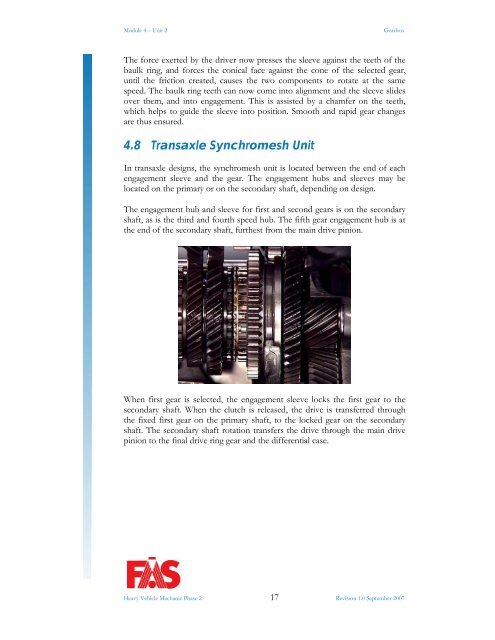TRADE OF HEAVY VEHICLE MECHANIC - eCollege
TRADE OF HEAVY VEHICLE MECHANIC - eCollege
TRADE OF HEAVY VEHICLE MECHANIC - eCollege
You also want an ePaper? Increase the reach of your titles
YUMPU automatically turns print PDFs into web optimized ePapers that Google loves.
Module 4 – Unit 2 Gearbox<br />
The force exerted by the driver now presses the sleeve against the teeth of the<br />
baulk ring, and forces the conical face against the cone of the selected gear,<br />
until the friction created, causes the two components to rotate at the same<br />
speed. The baulk ring teeth can now come into alignment and the sleeve slides<br />
over them, and into engagement. This is assisted by a chamfer on the teeth,<br />
which helps to guide the sleeve into position. Smooth and rapid gear changes<br />
are thus ensured.<br />
4.8 Transaxle Synchromesh Unit<br />
In transaxle designs, the synchromesh unit is located between the end of each<br />
engagement sleeve and the gear. The engagement hubs and sleeves may be<br />
located on the primary or on the secondary shaft, depending on design.<br />
The engagement hub and sleeve for first and second gears is on the secondary<br />
shaft, as is the third and fourth speed hub. The fifth gear engagement hub is at<br />
the end of the secondary shaft, furthest from the main drive pinion.<br />
When first gear is selected, the engagement sleeve locks the first gear to the<br />
secondary shaft. When the clutch is released, the drive is transferred through<br />
the fixed first gear on the primary shaft, to the locked gear on the secondary<br />
shaft. The secondary shaft rotation transfers the drive through the main drive<br />
pinion to the final drive ring gear and the differential case.<br />
Heavy Vehicle Mechanic Phase 2 17 Revision 1.0 September 2007
















